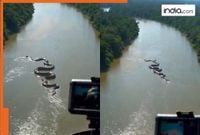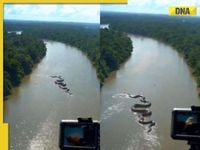A breathtaking video recently surfaced online, showcasing what appears to be a massive anaconda gracefully swimming along a stream in the depths of the Amazon jungle. Filmed from above, possibly by a drone or helicopter, the footage captured the attention of millions worldwide. Posted on the social media platform X (formerly Twitter), the video quickly went viral, accompanied by the caption, "Once again, a giant anaconda snake was spotted in the Amazon forests." However, as wonder gave way to skepticism, many viewers began to question the video's authenticity, speculating that it might have been manipulated using artificial intelligence (AI) or digitally created.
The video’s high-definition resolution and foreboding camera angles contributed to its sensational nature, while simultaneously igniting doubts among viewers. Some users were captivated by the rare glimpse into one of the world’s most isolated habitats, while others expressed concerns about the possibility of CGI or AI coding software being employed to create such content. With the rise of deepfakes and generative AI, the line between fact and fiction is increasingly blurred. As of now, no government body has authenticated the video, and without metadata or location tagging, its origin and authenticity remain uncertain.
The green anaconda, scientifically known as Eunectes murinus, is renowned as one of the world’s most powerful reptiles. Native to the Amazon and other regions of South America, these snakes are the largest in the world by weight and can grow to lengths exceeding 20 feet (6 meters) and weigh over 90 kilograms (200 pounds). Living primarily in dark, sluggish bodies of water such as swamps, marshes, and floodplains, anacondas prefer habitats that provide ample cover and food availability. Despite their intimidating appearance, they are non-toxic constrictors, capturing their prey through muscular pressure rather than venom. Their diet includes fish, birds, and even larger animals like capybaras and caimans.
The fascination surrounding anacondas has reached near-mythical proportions, fueled by tribal legends, sensationalized media, and popular culture. Sightings of these massive snakes in their natural environment often garner widespread publicity, regardless of context. In a similar vein, another viral video from last year showed Brazilian tourists mesmerized as a large anaconda slowly moved across a lake. The Instagram account Inside History shared the footage, explaining that the snake had recently eaten, which accounted for its sluggish movement. Such phenomena illustrate how digital media can amplify public interest and concern over wildlife, particularly large predators.
Adding to the intrigue, scientists made headlines in April 2025 by discovering a new, previously unknown species of anaconda in the Amazon. This significant finding occurred during a National Geographic expedition hosted by actor Will Smith. Led by Professor Bryan Fry from the University of Queensland, the team ventured into the remote Bameno area—one of the last untouched regions of the Amazon. Over a 10-day period, they were accompanied by Waorani hunters, who possess invaluable knowledge of the local territory and its fauna. The expedition successfully identified specimens of the new species in shallow waters, further emphasizing the diversity of life hidden within the Amazon rainforest.
The recent video of the anaconda has reignited discussions about wildlife authenticity in the digital age. As viewers continue to debate whether the footage is genuine or a product of digital manipulation, experts urge caution. The snake depicted in the video appears to exceed 10 meters in length, surpassing established scientific records for anacondas. While some viewers assert that the video captures an authentic sighting in a remote part of the Amazon, others remain skeptical, pointing to the lack of reliable sources confirming its authenticity.
In light of these developments, the question arises: should wildlife videos be authenticated before being shared? As the online discourse continues to unfold, the viral video has captivated audiences, regardless of its veracity. It has sparked renewed interest in one of the planet's most fascinating and feared reptiles, highlighting the delicate balance between scientific discovery and public perception.
In a related incident, a wildlife expert recently swam alongside a 26-foot-long anaconda, capturing a real video that further underscores the impressive size of these creatures. Earlier in 2025, researchers also identified a new type of anaconda known as the Northern Green Anaconda, which measured an astonishing 26 feet (almost 8 meters) in length. This discovery, made in another part of the Amazon, has amazed the scientific community and serves as a reminder of the many unknown species still lurking in the dense jungles.
The ongoing debate over the authenticity of the viral video serves as a microcosm of larger issues surrounding digital media and wildlife representation. As technology advances, the challenge of distinguishing genuine wildlife encounters from digitally fabricated content becomes increasingly complex. While the allure of the anaconda continues to capture imaginations, it also raises important questions about our relationship with nature and the narratives we construct around it.
As the world watches this captivating story unfold, it is essential to remain vigilant about the sources of information we consume and share. Whether real or a product of digital manipulation, the fascination with the anaconda endures, reminding us of the mysteries that still lie within the uncharted territories of our planet.





